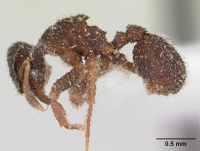Xerolitor explicatus
| Xerolitor explicatus | |
|---|---|

| |
| Scientific classification | |
| Kingdom: | Animalia |
| Phylum: | Arthropoda |
| Class: | Insecta |
| Order: | Hymenoptera |
| Family: | Formicidae |
| Subfamily: | Myrmicinae |
| Tribe: | Attini |
| Genus: | Xerolitor |
| Species: | X. explicatus |
| Binomial name | |
| Xerolitor explicatus (Kempf, 1968) | |
Identification
Distribution
Latitudinal Distribution Pattern
Latitudinal Range: -18.112222° to -22.809943°.
| North Temperate |
North Subtropical |
Tropical | South Subtropical |
South Temperate |
- Source: AntMaps
Distribution based on Regional Taxon Lists
Neotropical Region: Argentina, Brazil (type locality), Paraguay.
Distribution based on AntMaps
Distribution based on AntWeb specimens
Check data from AntWeb
Countries Occupied
| Number of countries occupied by this species based on AntWiki Regional Taxon Lists. In general, fewer countries occupied indicates a narrower range, while more countries indicates a more widespread species. |

|
Estimated Abundance
| Relative abundance based on number of AntMaps records per species (this species within the purple bar). Fewer records (to the left) indicates a less abundant/encountered species while more records (to the right) indicates more abundant/encountered species. |

|
Biology
|
Xerolitor explicatus is a member of the higher-attine ants, a clade that includes Sericomyrmex, Trachymyrmex, and the leaf-cutting ant genera Acromyrmex and Atta. The phylogeny further indicates that within the higher attines, X. explicatus is the sole representative of a depauperate evolutionary lineage that descended from a common ancestor, shared with the genus Sericomyrmex, that lived ∼15 Ma (Ješovnik et al., 2017). Our results are consistent with those of earlier studies (Branstetter et al., 2017; Ješovnik et al., 2017). Considering the cryptic biology of X. explicatus, it is possible that additional species of the currently monotypic genus Xerolitor remain to be discovered.
Castes
Nomenclature
The following information is derived from Barry Bolton's Online Catalogue of the Ants of the World.
- explicatus. Mycetosoritis explicata Kempf, 1968b: 401, figs. 14-16 (w.) BRAZIL.
- Sosa-Calvo, Brady & Schultz, 2009: 114 (q.).
- Status as species: Kempf, 1972a: 146; Bolton, 1995b: 269; Wild, 2007b: 33; Sosa-Calvo, Brady & Schultz, 2009: 114.
- Combination in Xerolitor: Sosa-Calvo et al., 2018: 557.
Type Material
- Holotype, worker, Anápolis, Goiás, Brazil, Museu de Zoologia da Universidade de Sao Paulo.
- Paratype, workers, Anápolis, Goiás, Brazil, Museu de Zoologia da Universidade de Sao Paulo.
Description
Head: Mandible triangular, masticatory margin with eight teeth, which increase gradually in size towards apex. Clypeal apron present, convex, medially concave. Median clypeal seta long (∼1/5 of mandible length), originating on anterior margin of clypeal apron emargination; lateral portion of clypeus with cluster of four to five clypeal hairs each. Preocular carina raised and extending posterad joining frontal carina at posterior cephalic margin forming complete antennal scrobe. Frontal lobe greatly expanded, covering antennal insertion, and jagged. Leading (anterior) edge of antennal scape denticulate, covered with subdecumbent long hairs that project toward apex; posterior edge of antennal scape lacking denticles and bearing appressed hairs. Mesosoma: Dorsum of pronotum flat and with some very low tubercles that bear some decumbent or subdecumbent hairs. Lateral margins of pronotum with denticulate carina. Lateral pronotal spine triangular, large. Lateral mesonotal tubercles large, triangular and keeled, with broad base. Posterior mesonotal lobes carinate. Dorsum of promesonotum forming shield, carinate on all sides, separated from lateral portions of promesonotum by abrupt right angles, and, posteriorly, overhanging and elevated above propodeum. Anterolateral face of propodeum with carinules ending in small tubercles. Metasoma: Petiolar node approximately as long as broad. Postpetiole wider than long; side bearing several denticles of similar length; posterior margin vestigially emarginated. First gastral tergite ovate, with pair of lateral longitudinal carinae along anterior two-thirds; dorsum with small, pimple-like, piligerous tubercles connected to each other by weak but distinct rugae, forming an areolate surface sculpture. In lateral view, first gastral tergite longer than sternite, dorsally overhanging remaining segments.
References
- Hanisch, P.E., Sosa-Calvo, J., Schultz, T.R. 2022. The last piece of the puzzle? Phylogenetic position and natural history of the monotypic fungus-farming ant genus Paramycetophylax (Formicidae: Attini). Insect Systematics and Diversity 6 (1): 11:1-17 (doi:10.1093/isd/ixab029).
- Kempf, W. W. 1968b. Miscellaneous studies on Neotropical ants. IV. (Hymenoptera, Formicidae). Stud. Entomol. 11: 369-415 (page 401, figs. 14-16 worker described)
- Sosa-Calvo, J., S. G. Brady and T. R. Schultz. 2009. The gyne of the enigmatic fungus-farming ant species Mycetosoritis explicata. Journal of Hymenoptera Research 18(1): 113-120.
- Sosa-Calvo, J., Schultz, T.R., Jesovnik, A., Dahan, R.A., Rabeling, C. 2018. Evolution, systematics, and natural history of a new genus of cryptobiotic fungus-growing ants. Systematic Entomology, 43, 549–567 (doi:10.1111/syen.12289).
References based on Global Ant Biodiversity Informatics
- Wild, A. L. "A catalogue of the ants of Paraguay (Hymenoptera: Formicidae)." Zootaxa 1622 (2007): 1-55.

